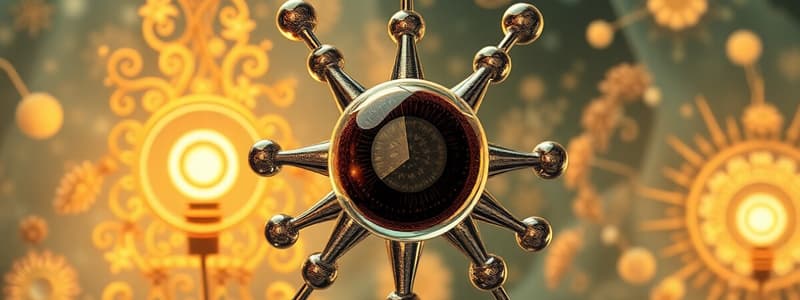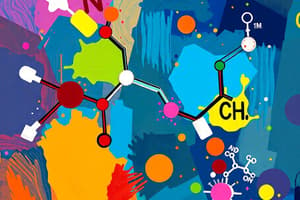Podcast
Questions and Answers
What is the fundamental atomic number Z of an element?
What is the fundamental atomic number Z of an element?
- The number of electrons in a neutral atom
- The combined number of protons and neutrons
- The number of protons in the nucleus of an atom (correct)
- The total number of neutrons in an atom
How many basic types of orbitals exist in atomic structure?
How many basic types of orbitals exist in atomic structure?
- Two: s and p
- Three: s, p, and d
- Four: s, p, d, and f (correct)
- Five: s, p, d, f, and g
In a neutral atom, what is true about the number of protons and electrons?
In a neutral atom, what is true about the number of protons and electrons?
- Electrons are absent.
- Protons outnumber electrons.
- They are always equal. (correct)
- Protons and neutrons are equal.
Which statement correctly identifies orbitals?
Which statement correctly identifies orbitals?
Which of the following topics is NOT a key objective of the Pharmaceutical Organic Chemistry course?
Which of the following topics is NOT a key objective of the Pharmaceutical Organic Chemistry course?
What is the main reason atoms tend to follow the octet rule?
What is the main reason atoms tend to follow the octet rule?
Which type of bond involves the sharing of electrons between nonmetals?
Which type of bond involves the sharing of electrons between nonmetals?
In a double bond, how many total bonds are formed between two atoms?
In a double bond, how many total bonds are formed between two atoms?
What is the term for electrons that are not involved in chemical bonding?
What is the term for electrons that are not involved in chemical bonding?
Which theory suggests that the overlap of incompletely filled atomic orbitals results in chemical bonds?
Which theory suggests that the overlap of incompletely filled atomic orbitals results in chemical bonds?
Flashcards
Atomic Number (Z)
Atomic Number (Z)
The number of protons in an atom's nucleus, unique to each element.
Atomic Orbitals
Atomic Orbitals
Specific regions around an atom's nucleus where electrons are most likely to be found.
Electron
Electron
Negatively charged particle orbiting the atom's nucleus.
Chemical Bonding
Chemical Bonding
Signup and view all the flashcards
Orbital Types
Orbital Types
Signup and view all the flashcards
Octet Rule
Octet Rule
Signup and view all the flashcards
Ionic Bond
Ionic Bond
Signup and view all the flashcards
Covalent Bond
Covalent Bond
Signup and view all the flashcards
Sigma (σ) Bond
Sigma (σ) Bond
Signup and view all the flashcards
Valence
Valence
Signup and view all the flashcards




